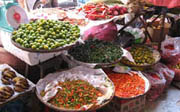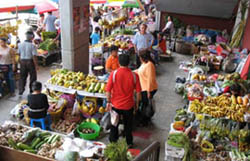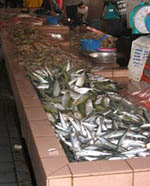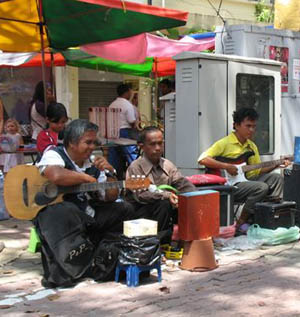Follow Your Nose To a Tasty Borneo
Delicacy
Kota Kinabalu, Sabah
by Sarah Shuckburgh
Kota Kinabalu may have changed since Sarah Shuckburgh first visited , but its
market is as pungent and chaotic as ever.
 You can smell the durians long before you see them. The
prickly yellow fruits stink of drains and rancid meat, and
laws forbid you from taking them on buses or into hotels.
But when you cut open a durian (blocking your nose), the
soft flesh is a famously tasty delicacy. You can smell the durians long before you see them. The
prickly yellow fruits stink of drains and rancid meat, and
laws forbid you from taking them on buses or into hotels.
But when you cut open a durian (blocking your nose), the
soft flesh is a famously tasty delicacy.
Much has changed in Kota Kinabalu since my first visit 17
years ago, but the central market is still a pungent and
colourful cornucopia. The stifling labyrinth of narrow
alleys is crammed with stalls displaying weird local produce
- bundles of dainty fern tips, hairy red rambutans,
translucent pink and green rose-apples, pinkish papayas,
giant yellow fern tips, hairy red rambutans,
translucent pink and green rose-apples, pinkish papayas,
giant yellow pomelos, jackfruit with tight clusters of
prickles, smooth pale mangoes, tiny beige langsats,
mountains of dark green watermelons, pointed starfruit,
purple mangosteens with leafy rosettes, tiny yellow dukus,
knobbly breadfruit, tufted coconuts, plump bruised bananas
and sayur manis – thin stems with tender leaves, a local
speciality. pomelos, jackfruit with tight clusters of
prickles, smooth pale mangoes, tiny beige langsats,
mountains of dark green watermelons, pointed starfruit,
purple mangosteens with leafy rosettes, tiny yellow dukus,
knobbly breadfruit, tufted coconuts, plump bruised bananas
and sayur manis – thin stems with tender leaves, a local
speciality.
The dried and preserved foods are also startling – vats of
soya-bean curd, bunches of dried fish, and extraordinary
eggs, buried in mud until the white becomes brown jelly and
the yolk turns inky black. Everything is wrapped in plastic,
and there are no flies or piles of rubbish. Smokers buy
curled cylinders of dried pandanus leaves to roll round
locally grown tobacco, or bundles of heart-shaped leaves to
chew with red and black betel nut and w hite lime. A strong
clove-smell of kretek cigarettes hangs in the humid air. hite lime. A strong
clove-smell of kretek cigarettes hangs in the humid air.
Hopping over yard-deep monsoon drains, we visit Kota
Kinabalu’s covered fish market, where a fantastic assortment
of seafood is artistically arranged on concrete slabs, with
tails fanning out, whiskered heads wedged upright,
glistening bodies aligned - huge Pacific oysters,
cuttlefish, yellow-fin tuna, tiger prawns, squid,
saucer-sized mussels, crabs, lobsters. Small children sluice
the displays with water, while adults squat by bowls of grey
water, washing fish and throwing guts aside. fanning out, whiskered heads wedged upright,
glistening bodies aligned - huge Pacific oysters,
cuttlefish, yellow-fin tuna, tiger prawns, squid,
saucer-sized mussels, crabs, lobsters. Small children sluice
the displays with water, while adults squat by bowls of grey
water, washing fish and throwing guts aside.
Back in the central market we climb stone steps, obeying
signs in Malay, Chinese and English saying ‘Do Not Spit’. On
the upper floor, stalls offer tracksuits, shoes, handbags
and Wayne Rooney football shirts. I buy two pairs of sandals
for £2. Ducking under a plastic curtain, we find a vast
open-sided hall with trestle tables. Hundreds of shoppers
are tucking into soup, rice and meat.

After quenching our thirst with sugar-cane juice and soya-bean
milk, we join throngs of pedestrians on a raised walkway
leading from the market across two traffic-choked roads
towards a formal square with flags and fountains. Steps lead
down to busy side-streets lined with open-fronted shops.
Chinese music blares out. Women sit on low stools, checking
children’s heads for lice. Youths doze on piles of canned
food. Shopkeepers lean on their bales of gaudy cottons.
While a band of blind street musicians plays amplified Asian
pop, we have our feet and shins pummelled and kneaded by
blind reflexologists. Later, we have lunch in a crowded café
called the Hungry Muslim. Diners are watching American
 wrestling on a flickering television. Lizards stare down
from the flaking ceiling. On the pavement, the cook is
preparing fritters, dipping slivers of banana in a dustbin
of batter before throwing them into a massive wok of
bubbling oil. Our delicious lunch – including banana
fritters – costs us £1.10. wrestling on a flickering television. Lizards stare down
from the flaking ceiling. On the pavement, the cook is
preparing fritters, dipping slivers of banana in a dustbin
of batter before throwing them into a massive wok of
bubbling oil. Our delicious lunch – including banana
fritters – costs us £1.10.
We have not seen another tourist all day, but away from the
central market and crowded street-cafes, Kota Kinabalu has
undergone rapid social change.

In 1979, my brother James, as part of his medical training,
spent six months working at Kota Kinabalu’s hospital. His
letters, which my mother has kept, describe a small,
low-rise colonial town surrounded by coastal plantations of
banana, cocoa, coffee, rice and pineapple. The hospital was
cluttered and chaotic. Patients often disappeared in the
night, stolen by relatives who distrusted western medicine.
At Chinese New Year the wards emptied as everyone ran away
to enjoy the festivities. Much of the doctors’ work was
stitching knife wounds – one of the few words that Malay has
given to the English language is ‘amok’, the blind rage with
which locals attacked each other with parangs.
There were almost no roads into the interior in 1979.
Logging had begun, but primary rainforest still covered most
of the vast island of Borneo. Tribal villages were
inaccessible except on foot, perhaps a week’s walk from the
nearest track. Doctors reached outstation clinics by
helicopter – a turbulent ride over the steaming jungle. In
remote kampongs of stilted longhouses, while Kadizans banged
copper kenongs and performed their strutting bird-courtship
dance, barefoot doctors dispensed pills and medicine with
slim hopes of their instructions being followed.
 James was adopted by the expat clique, who, with a few
Malaysian timber millionaires, drove their speedboats to the
islands, watched a weekly film on an outdoor screen at the
British Council, and went on an occasional ‘hash’ – a
paperchase along jungle paths, through prickly pineapple
plantations, across rope bridges, through thigh-deep rivers,
with false trails and trip-wires which set off loud fire
crackers. James was adopted by the expat clique, who, with a few
Malaysian timber millionaires, drove their speedboats to the
islands, watched a weekly film on an outdoor screen at the
British Council, and went on an occasional ‘hash’ – a
paperchase along jungle paths, through prickly pineapple
plantations, across rope bridges, through thigh-deep rivers,
with false trails and trip-wires which set off loud fire
crackers.
My husband and I visited Sabah for the first time in 1990 –
by chance, three months before my brother James died of
cancer, aged 33. By then, vast tracts of primary rainforest
had gone, replaced by rubber plantations. Kota Kinabalu had
sprouted tall buildings and some hotels, and while James had
journeyed for six hours along bumpy jungle tracks to reach
the base of Mount Kinabalu, our drive to Kinabalu National
Park was smooth and quick.
On our return in 2007, we find further dramatic changes.
Lucrative palm oil plantations now cover the country, which
is crisscrossed with logging roads. Only a few patches of
rainforest remain, and the traditional stilted houses are
now best seen in the state museum, where longhouses and
other dwellings have been assembled in a Heritage Village.
KK has become a sophisticated international resort - we
began and ended our trip staying with 1000 other guests in
luxury air-conditioned hotel complexes with restaurants,
nightclubs, pools, gyms, spas, golf courses, video games
rooms and hundreds of smiling staff in immaculate uniforms.

But the magic of Kota Kinabalu has not disappeared. As James
did 28 years ago, we took a speedboat to Mamutik, the
smallest of KK’s forested islands, and spent an idyllic
afternoon strolling on sand as soft and white as icing
sugar, listening to the cooing of tiny doves and to the
gently lapping South China Sea. The sky was heavy and grey,
but underwater the coral reef glowed - a vibrant landscape
of dusty blues, vivid yellows, reds, greens and browns,
inhabited by black spiky sea urchins, blue snake-like fish
emerging from holes in the coral, and shoals of iridescent
fish in harlequin spots and stripes.
My brother would also recognise the humidity, the heat, the
lizards, the torrential rains, the streets thronging with
KK’s extraordinarily diverse and friendly people, the
coconut shells of thirst-quenching milk, the sugar-cane
juice, the sizzling banana fritters - and the delicious
stinking durians.
First published by the Telegraph
©SarahShuckburgh |